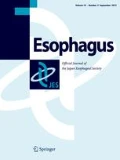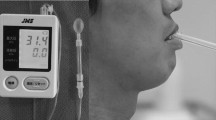Abstract
Background
Dysphagia is a prominent symptom after esophagectomy and may cause aspiration pneumonia. Swallowing evaluation after esophagectomy can predict and help control the incidence of postoperative pneumonia. The aim of this study was to clarify whether the change in tongue pressure was associated with any related factor and postoperative dysphagia/pneumonia in patients with esophageal cancer after esophagectomy.
Methods
Fifty-nine inpatients (41 males and 18 females; 33–77 years old) who underwent esophagectomy participated in this study. Measurement of tongue pressure and the repetitive saliva swallowing test (RSST) was performed before esophagectomy (baseline) and at 2 weeks postoperatively. The general data were collected from patients’ medical records, including sex, age, type of cancer, cancer stage, location of cancer, operative approach, history of previous chemotherapy, surgical duration, amount of bleeding during surgery, incidences of postoperative complications, intubation period, period between surgery and initiation of oral alimentation, and intensive care unit (ICU) stay, blood chemical analysis, and lifestyle.
Results
Tongue pressure decreased significantly after esophagectomy (p = 0.011). The decrease of tongue pressure was significantly associated with length of ICU stay and preoperative tongue pressure on multiple regression analysis (p < 0.05). The decrease of tongue pressure in the RSST < 3 or postoperative pneumonia (+) group was significantly greater than in the RSST ≥ 3 (p = 0.003) or pneumonia (−) group (p = 0.021).
Conclusions
The decrease in tongue pressure was significantly associated with the length of ICU stay, preoperative tongue pressure, and the incidence of dysphagia and pneumonia among inpatient after esophagectomy.


Similar content being viewed by others
References
Tachimori Y, Ozawa S, Numasaki H, et al. Comprehensive registry of esophageal cancer in Japan, 2009. Esophagus. 2009;13:110–37.
Martin RE, Letsos P, Taves DH, et al. Oropharyngeal dysphagia in esophageal cancer before and after transhiatal esophagectomy. Dysphagia. 2001;16:23–31.
Kaneoka A, Yang S, Inokuchi H, et al. Presentation of oropharyngeal dysphagia and rehabilitative intervention following esophagectomy: a systematic review. Dis Esophagus. 2018;31:1–11.
Heitmiller RF, Jones B. Transient diminished airway protection after transhiatal esophagectomy. Am J Surg. 1991;162:442–6.
Atkins BZ, Shah AS, Hutcheson KA, et al. Reducing hospital morbidity and mortality following esophagectomy. Ann Thorac Surg. 2004;78:1170–6.
Wu N, Zhu Y, Kadel D, et al. The prognostic influence of body mass index, resting energy expenditure and fasting blood glucose on postoperative patients with esophageal cancer. BMC Gastroenterol. 2016;16:142.
Taioli E, Schwartz RM, Lieberman-Cribbin W, et al. Quality of life after open or minimally invasive esophagectomy in patients with esophageal cancer—a systematic review. Semin Thorac Cardiovasc Surg. 2017;29:377–90.
Yamamoto M, Yamasaki M, Sugimoto K, et al. Risk evaluation of postoperative delirium using comprehensive geriatric assessment in elderly patients with esophageal cancer. World J Surg. 2016;40:2705–12.
Ra J, Paulson EC, Kucharczuk J, et al. Postoperative mortality after esophagectomy for cancer: development of a preoperative risk prediction model. Ann Surg Oncol. 2008;15:1577–84.
Berry MF, Atkins BZ, Tong BC, et al. A comprehensive evaluation for aspiration after esophagectomy reduces the incidence of postoperative pneumonia. J Thorac Cardiovasc Surg. 2010;140:1266–71.
Hasegawa Y, Sugahara K, Fukuoka T, et al. Change in tongue pressure in patients with head and neck cancer after surgical resection. Odontology. 2017;105:494–503.
Ono T, Kumakura I, Arimoto M, et al. Influence of bite force and tongue pressure on oro-pharyngeal residue in the elderly. Gerodontology. 2007;24:143–50.
Okumura T, Shimada Y, Watanabe T, et al. Functional outcome assessment of swallowing (FOAMS) scoring and videofluoroscopic evaluation of perioperative swallowing rehabilitation in radical esophagectomy. Surg Today. 2016;46:543–51.
Takahashi M, Koide K, Arakawa I, et al. Association between perioral muscle pressure and masticatory performance. J Oral Rehabil. 2013;40:909–15.
Oguchi K, Saitoh E, Baba M, et al. The Repetitive Saliva Swallowing Test (RSST) as a screening test of functional dysphagia (2) validity of RSST. Jpn J Rehabil Med. 2000;37:383–8 (in Japanese).
Tsubosa Y, Sato H, Tachimori Y, et al. Multi-institution retrospective study of the onset frequency of postoperative pneumonia in thoracic esophageal cancer patients. Esophagus. 2014;11:126–35.
Yokoi A, Maruyama T, Yamanaka R, et al. Relationship between acetaldehyde concentration in mouth air and tongue coating volume. J Appl Oral Sci. 2015;23:64–70.
Henderson AR. Testing experimental data for univariate normality. Clin Chim Acta. 2006;366:112–29.
Faul F, Erdfelder E, Lang AG, et al. G*Power 3: a flexible statistical power analysis program for the social, behavioral, and biomedical sciences. Behav Res Methods. 2007;39:175–91.
Pereira NC, Turrini RNT, Poveda VB. Perioperative fasting time among cancer patients submitted to gastrointestinal surgeries. Rev Esc Enferm USP. 2017;51:e03228.
Chang YL, Tsai YF, Wu YC, et al. Factors relating to quality of life after esophagectomy for cancer patients in Taiwan. Cancer Nurs. 2014;37:4–13.
Luc G, Durand M, Chiche L, et al. Major post-operative complications predict long-term survival after esophagectomy in patients with adenocarcinoma of the esophagus. World J Surg. 2015;39:216–22.
Yoshikawa H, Furuta K, Ueno M, et al. Oral symptoms including dental erosion in gastroesophageal reflux disease are associated with decreased salivary flow volume and swallowing function. J Gastroenterol. 2012;47:412–20.
Oba S, Tohara H, Nakane A, et al. Screening tests for predicting the prognosis of oral intake in elderly patients with acute pneumonia. Odontology. 2017;105:96–102.
Robbins J, Gangnon RE, Theis SM, et al. The effects of lingual exercise on swallowing in older adults. J Am Geriatr Soc. 2005;53:1483–9.
Fregosi RF, Ludlow CL. Activation of upper airway muscles during breathing and swallowing. J Appl Physiol. 1985;2014(116):291–301.
Scholtemeijer MG, Seesing MFJ, Brenkman HJF, et al. Recurrent laryngeal nerve injury after esophagectomy for esophageal cancer: incidence, management, and impact on short- and long-term outcomes. J Thorac Dis. 2017;9:S868–78.
Lee SY, Cheon HJ, Kim SJ, et al. Clinical predictors of aspiration after esophagectomy in esophageal cancer patients. Support Care Cancer. 2016;24:295–9.
Huang Q, Zhong J, Yang T, et al. Impacts of anastomotic complications on the health-related quality of life after esophagectomy. J Surg Oncol. 2015;111:365–70.
Pillon J, Gonçalves MI, De Biase NG. Changes in eating habits following total and frontolateral laryngectomy. Sao Paulo Med J. 2004;122:195–9.
Veldhuis D, Probst G, Marek A, et al. Tumor site and disease stage as predictors of quality of life in head and neck cancer: a prospective study on patients treated with surgery or combined therapy with surgery and radiotherapy or radiochemotherapy. Eur Arch Otorhinolaryngol. 2016;273:215–24.
Yoshida N, Watanabe M, Baba Y, et al. Risk factors for pulmonary complications after esophagectomy for esophageal cancer. Surg Today. 2014;44:526–32.
Shiozaki A, Fujiwara H, Okamura H, et al. Risk factors for postoperative respiratory complications following esophageal cancer resection. Oncol Lett. 2012;3:907–12.
Yamanashi H, Shimizu Y, Higashi M, et al. Validity of maximum isometric tongue pressure as a screening test for physical frailty: cross-sectional study of Japanese community-dwelling older adults. Geriatr Gerontol Int. 2018;18:240–9.
Utanohara Y, Hayashi R, Yoshikawa M, et al. Standard values of maximum tongue pressure taken using newly developed disposable tongue pressure measurement device. Dysphagia. 2008;23:286–90.
Yatabe T, Kitagawa H, Yamashita K, et al. Comparison of the perioperative outcome of esophagectomy by thoracoscopy in the prone position with that of thoracotomy in the lateral decubitus position. Surg Today. 2013;43:386–91.
Liu YW, Yan FW, Tsai DL, et al. Expedite recovery from esophagectomy and reconstruction for esophageal squamous cell carcinoma after perioperative management protocol reinvention. J Thorac Dis. 2017;9:2029–37.
Acknowledgements
This work was supported by Grants-in-Aid for Scientific Research (no. 15K11416) from the Ministry of Education, Culture, Sports, Science and Technology, Tokyo, Japan.
Author information
Authors and Affiliations
Corresponding author
Ethics declarations
Conflict of interest
Aya Yokoi, Daisuke Ekuni, Reiko Yamanaka, Hironobu Hata, Yasuhiro Shirakawa, and Manabu Morita declare that they have no conflict of interest.
Ethical Statement
All procedures followed were in accordance with the ethical standards of the responsible committees on human experimentation (institutional and national) and with the Helsinki Declaration of 1964 and later versions.
Informed consent
Written, informed consent was obtained from all patients for inclusion in the study.
Additional information
Publisher's Note
Springer Nature remains neutral with regard to jurisdictional claims in published maps and institutional affiliations.
Rights and permissions
About this article
Cite this article
Yokoi, A., Ekuni, D., Yamanaka, R. et al. Change in tongue pressure and the related factors after esophagectomy: a short-term, longitudinal study. Esophagus 16, 300–308 (2019). https://doi.org/10.1007/s10388-019-00668-x
Received:
Accepted:
Published:
Issue Date:
DOI: https://doi.org/10.1007/s10388-019-00668-x




